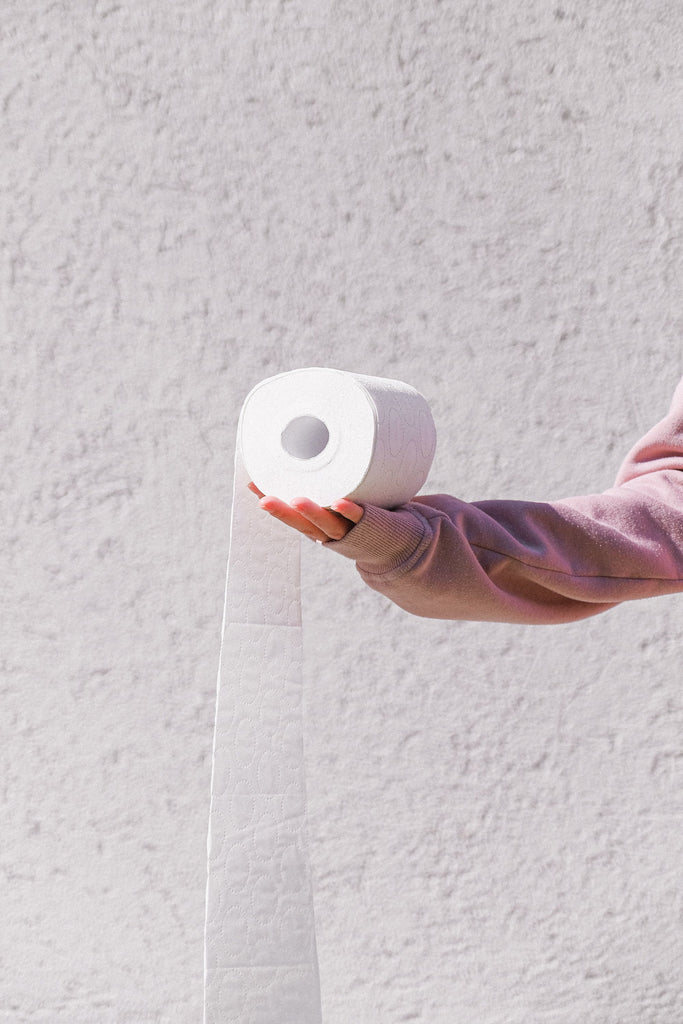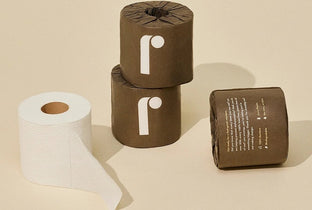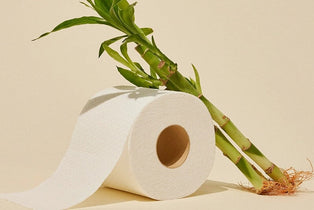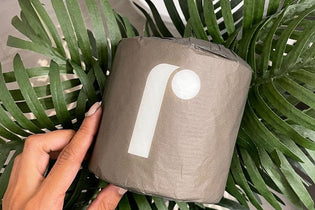
TLDR
We use it every single day, but most of us know very little about toilet paper itself. You may have wondered when toilet paper was invented, how toilet paper is made, or what people used before toilet paper. The answers to all your most pressing questions will lead you toward toilet paper enlightenment.

Understanding the history behind toilet paper and the processes used to manufacture the different types of paper will help you make informed buying decisions that benefit you, your wallet, and the environment.
Here’s everything you need to know about toilet paper!
What Did People Use Before Toilet Paper?
Before they had toilet paper, people still had to clean themselves. They simply did so in much more creative ways... some of which may have been a bit too creative.
From Ancient Rome to the Middle Ages and beyond, people have cleaned up in all sorts of ways after using the bathroom. So, what did people use before toilet paper?
The Roman Solution
In Ancient Rome, citizens became accustomed to using public bathrooms that were remarkably similar to modern toilets and outhouses. Unlike today, though, after doing their business, they didn’t clean up with a few squares of toilet paper.
Instead, they used a tersorium – basically a sponge skewered on the end of a stick. The tersoria would sit next to toilets, and Romans would wipe themselves with one once they had finished with their business.
Although a tersorium would be used several times by different latrine-goers, they were at least friendly enough to rinse off the sponge for the next person.
Cleaning Up in the Middle Ages
The invention of the printing press in 1440 allowed for the mass production and distribution of books, pamphlets, and other printed materials.
Not everyone could read, but paper products were abundant. Since toilet paper was yet to be invented, your next best bet was to rip out a page from your favorite pamphlet.
Without toilet paper, society in the middle-to-late 15th century would often use pages of books, essays, pamphlets, and other texts to clean up after they had used the bathroom.
Farming for a Solution
If you lived on a farm, you likely lived miles away from the nearest town. As a result, early farmers had to become self-reliant and get very creative in the absence of toilet paper.
By far, the most popular clean-up method for farmers and their families was a corncob. Yes, they used a corncob – stripped of all kernels – to wipe themselves after using the outhouse.
The corncob’s shocking popularity lingered even after toilet paper had been invented, meaning that through the 19th century (and likely into the 20th), people were still using corncobs in the outhouse.
When Was Toilet Paper Invented?
Over the centuries, toilet paper has evolved. As a result, the invention of toilet paper was more of an ongoing process than a set date, and its origins are drastically different than our 21st-century soft and fluffy rolls of goodness. The process began in China and ended with the many sustainable toilet paper alternatives we know and love today.

According to National Geographic, the first recognizable form of toilet paper was created for the Chinese imperial family in 1393. The imperial toilet tissue was rice-based and presented as a stack of individual, perfumed sheets.
The Rise of Modern Toilet Paper
Although toilet paper was first developed at the end of the 14th century, it wouldn’t be until the late 19th century that toilet paper was mass-produced.
In 1857, Joseph Gayetty developed his own line of aloe-infused hemp toilet paper. Gayetty thought the idea was so ingenious that he had his last name printed on every sheet! Unfortunately, Americans preferred to wipe with pages out of the – free – Sears Roebuck catalog, so few people bought his toilet paper.
Then, around 1890, two brothers, Clarence and Irvin Scott, began to produce toilet paper on a roll. During the 1930s, stores started to sell toilet paper in packs of rolls, and Charmin began marketing toilet paper as a soft commodity.
By 1970, Americans had become wholly dependent on the use of toilet paper; however, toilet paper innovation was far from over. As we reached the 21st century, we started to see sustainable toilet paper options emerge.
Chiefly, Reel Paper has changed the game by offering soft and sustainable bamboo toilet paper.
What Is Toilet Paper Made Of?
Toilet paper may be a household staple, but how many of us have actually questioned what our go-to brand is made of? Knowing exactly what is in the item we use on our most sensitive areas empowers us to make active, informed decisions, as opposed to simply grabbing whatever brand is on sale.
Traditional toilet paper – as with most paper products – comes from trees. In fact, a company called Northern Tissue announced the first-ever guaranteed splinter-free toilet paper in 1930!
Luckily, modern toilet paper is proudly splinter-free and generally made from one of two materials: virgin or recycled pulp.
Virgin pulp comes directly from a tree specifically to make toilet paper. Recycled pulp, on the other hand, comes from existing paper products; in fact, recycled pulp can potentially have been used many times prior to becoming toilet paper.
What may surprise you though, is to learn that despite the name, you can’t actually recycle recycled toilet paper. Luckily, there are other toilet paper options out there. One of the best things you can do for both your behind and the environment is to make the switch to bamboo toilet paper!
How Is Toilet Paper Made?
Toilet paper companies use two individual manufacturing processes depending on whether they’re making virgin or recycled toilet paper.
Toilet Paper From Virgin Pulp
The process of producing toilet paper from virgin pulp is unique. First, the makers will cut down the tree, remove its bark, and chip the wood into small pieces. They then pressure cook the wood chips to produce a pulp.

After that, they wash and bleach the pulp until it’s colorless, mix the pulp with water, and strain, press, and dry the pulp to its final moisture level.
Once the pulp is dry, it’s perforated and rolled into a long paper log. Finally, they cut the log into smaller rolls and package them for consumer use.
Toilet Paper From Recycled Pulp
Unlike the virgin pulp method, the process of making recycled toilet paper begins with dumping a load of recycled paper into a bin filled with warm water. The water is then aerated to remove any ink from the paper, then bleached and sanitized.
The manufacturers press and dry the pulp on a large, flat surface and emboss the dried pulp to strengthen it. To make a two-ply roll, they feed the mixture through a machine that glues the sheets together.
Finally, using a circular saw, they cut the rolls and then wrap them for individual sale.
What Is the Healthiest Toilet Paper?
What exactly is “healthy” toilet paper? Toilet paper’s health corresponds to how a particular brand affects people and the environment.
Toilet paper that’s good for people is free of toxins. Many production processes use chlorine bleach to whiten or sanitize pulp. Some toilet paper even contains the chemical BPA – which evidence suggests may be harmful.
Toilet paper that’s good for the environment promotes sustainability and the health of our planet. We cut down 27,000 trees every day just to make toilet paper – none of which can be recycled. Many sustainable alternatives use non-tree materials like bamboo or hemp.
Fortunately, here at Reel Paper, we produce high-quality toilet paper that’s good for you and the environment. Our bamboo toilet paper is free of inks and dyes and is completely sustainable from start to finish. We even offer a line of fun toilet paper for kids, as well as bulk toilet paper to help you save.
How Long Is a Toilet Paper Roll?
Toilet paper comes in all shapes and sizes that vary in length and softness. According to one MIT student, a standard roll of toilet paper is about 4.5 inches in diameter. The number of sheets per roll varies depending on the product. Generally, two-ply paper has about 500 sheets per roll whereas one-ply paper has around 1000 sheets per roll.
Depending on bathroom habits, one roll of toilet paper may last longer for some people than others. A toilet paper calculator can estimate how long your toilet paper will last based on how many rolls you have and how often you use the bathroom, so you can gauge when you’ll need to restock your supply.
Toilet Paper & You
You’ve just learned a lot about toilet paper! Whether you choose to use virgin or recycled paper, always remember that some toilet paper is good for you, some is good for the environment, and some is good for both. At Reel, we ensure that all of our paper products are good for both, from our recycled paper towels to our bamboo toilet paper.
Knowing how companies make toilet paper, what makes toilet paper healthy, and how long the average roll is, as well as your options and their pros and cons, will help you choose the best toilet paper for you and your family.
To learn even more about toilet paper, sign up for our newsletter!



2 comments
Hello. I have a question in my mind, can we produce toilet paper from waste papers?
Abdul Matin on
James Fauset on